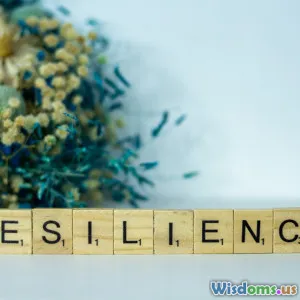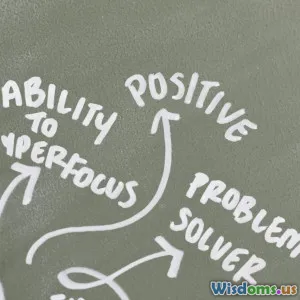
Student Athletes and the Secrets to Building Everyday Resilience
8 min read Explore how student athletes develop everyday resilience through strategies like mindset shifts, time management, and support networks. (0 Reviews)
Student Athletes and the Secrets to Building Everyday Resilience
Introduction
Imagine juggling the relentless pressures of competitive sports and demanding academic commitments simultaneously—this is the daily reality for many student athletes. Whether they're sprinting to the finish line or racing against deadlines, resilience emerges as their secret weapon. But what is resilience exactly?
Resilience is the dynamic process of adapting well in the face of adversity, trauma, or significant stress. For student athletes, this means more than bouncing back from a tough loss; it encompasses thriving amid attendance pressures, coping with injuries, managing social expectations, and excelling academically.
In this article, we dive deep into the multifaceted secrets that empower student athletes to build everyday resilience. Supported by insights, research, and real-world examples, we'll explore mindset shifts, time management, social support, and mental health practices critical for sustained success.
Understanding the Unique Challenges Student Athletes Face
Student athletes face a cocktail of stressors unlike most peers:
- Time constraints: A 2019 NCAA study found Division I athletes commit an average of 34 hours per week to sport-related activities—akin to a full-time job—while maintaining full course loads.
- Physical and mental fatigue: Grueling training schedules paired with academic deadlines often lead to burnout.
- High expectations: Coaches, teammates, family, and sometimes their own ambitions create pressure to perform constantly.
- Social sacrifices: Missing social events or downtime can heighten feelings of isolation.
These overlapping pressures create a crucible where resilience becomes essential for not just survival, but thriving.
Secret 1: Cultivating a Growth Mindset
Psychologist Carol Dweck’s groundbreaking research on growth versus fixed mindsets highlights how belief systems shape resilience. Student athletes with a growth mindset view failures and setbacks as opportunities for learning rather than permanent deficiencies.
For example, Serita Whitaker, a collegiate volleyball player, recalls losing a crucial match early in her career. Instead of succumbing to disappointment, she embraced feedback from coaches and teammates, adjusted her strategy, and eventually led her team to a championship.
Practical tip: Student athletes can practice positive self-talk, embrace challenges outside their comfort zones, and reflect regularly on lessons learned from setbacks.
Secret 2: Mastering Time Management and Prioritization
Effectively managing time splits resilience from overwhelm. Many student athletes credit structured schedules to their capacity for balancing demands. The NCAA noted that athletes who utilize planners or digital calendars report lower stress.
Case study: Mia Thompson, a track and field athlete, schedules her academic, training, meals, and rest blocks meticulously each week. This anticipation mitigates deadline surprises and preserves energy.
Using the Eisenhower Matrix—prioritizing tasks based on urgency and importance—helps eradicate procrastination and ensures academic responsibilities don’t fall behind.
Secret 3: Building Strong Social Support Networks
Resilience flourishes in connection. A study published in the Journal of Sport Psychology (2018) found that athletes with supportive relationships—coaches, teammates, family, and friends—exhibit superior psychological resilience and reduced anxiety.
Example: Michael, a college basketball player, credits his coach’s approachable leadership style for instilling confidence, which helped him rebound from a season-ending injury.
Additionally, peer support groups for student athletes foster shared experiences, normalize struggles, and offer emotional validation.
Secret 4: Prioritizing Mental Health and Self-Care
The stigma around mental health is eroding in athletics, but challenges remain. According to a 2020 NCAA survey, nearly 30% of student athletes reported symptoms of depression or anxiety.
Integrating mindfulness interventions, like meditation and breathing exercises, has been proven to reduce performance anxiety and enhance focus. Elite gymnast Simone Biles openly discusses how addressing her mental health was pivotal to regaining control amid overwhelming pressure.
Self-care routines—nutrition, sleep hygiene, and downtime—are foundational. Poor sleep is linked with impaired motivation and injury risk; thus, student athletes who prioritize rest unlock performance gains.
Tip: Incorporate quick mindfulness breaks into daily schedules and seek counseling resources when feeling overwhelmed.
Secret 5: Setting Realistic, Incremental Goals
A target uncluttered by overwhelm is easier to pursue. Instead of focusing solely on winning championships, resilient student athletes break down their objectives into attainable milestones.
Dr. Angela Duckworth, a psychologist studying grit, notes that passion paired with long-term persistence relies heavily on goal-setting strategies.
Example: A swimmer recovering from injury sets interim goals like regaining stroke technique, followed by lap times. This approach builds motivation and tracks progress.
Real-World Insight: Testimonials from Resilient Student Athletes
-
Jasmine Rodriguez, a soccer player balancing training with pre-med coursework, shares: “Resilience isn’t just physical toughness. It’s about mental clarity and community. When I feel drained, reaching out to teammates or mentors resets me.”
-
Ethan Liu, a tennis player, overcame academic probation by adopting structured study sessions and being candid about struggles, highlighting vulnerability as part of resilience.
These voices embody how resilience is cultivated daily through intentional practices.
Conclusion
Student athletes' experiences illuminate that resilience is not innate; it's built piece by piece through mindset, strategy, support, and self-awareness. By embracing failures as growth opportunities, mastering time, leaning on community, caring for mental health, and setting manageable goals, student athletes construct the backbone to persist amid adversity.
This everyday resilience doesn’t only fuel athletic or academic success but forges life skills that transcend fields and classrooms.
Actionable takeaway: Whether you’re a student athlete or striving for personal goals under pressure, adopting these resilience-building secrets can transform challenges into stepping stones toward greater achievement.
References:
- NCAA GOALS Study, 2019
- Dweck, C.S. (2006). Mindset: The New Psychology of Success.
- Journal of Sport Psychology, 2018
- NCAA Mental Health Survey, 2020
- Duckworth, A. (2016). Grit: The Power of Passion and Perseverance.
- Personal interviews with collegiate student athletes
Rate the Post
User Reviews
Popular Posts




















